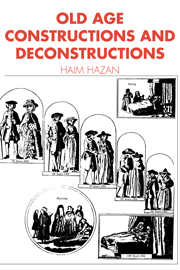Book contents
- Frontmatter
- Contents
- Acknowledgements
- Introduction: towards knowledge of old age
- PART I REPRESENTATIONS OF AGEING: LANGUAGES ABOUT OLD AGE
- PART II PRESENTATIONS OF AGEING: LANGUAGES OF THE OLD
- 5 Control: the social boundaries of age
- 6 Meaning: the cultural boundaries of life
- 7 Another universe: time, space, and self
- Conclusions: the nature of knowledge about ageing
- Notes
- Bibliography
- Index
5 - Control: the social boundaries of age
Published online by Cambridge University Press: 05 June 2012
- Frontmatter
- Contents
- Acknowledgements
- Introduction: towards knowledge of old age
- PART I REPRESENTATIONS OF AGEING: LANGUAGES ABOUT OLD AGE
- PART II PRESENTATIONS OF AGEING: LANGUAGES OF THE OLD
- 5 Control: the social boundaries of age
- 6 Meaning: the cultural boundaries of life
- 7 Another universe: time, space, and self
- Conclusions: the nature of knowledge about ageing
- Notes
- Bibliography
- Index
Summary
The variety in the status of the aged in different societies is enormous. Comparative anthropological research on the aged in various cultural milieux has revealed relatively few common denominators (see, e.g., Simmons 1945; Cowgill and Holmes 1971; Myerhoff and Simic 1978; Amoss and Harell 1981a: Fry 1980; Sokolovsky 1983). Before discussing the sources of such differences, it may be useful to illustrate their range.
In hunter-gatherer societies living at the subsistence level, the conditions of daily life render the situation of the older person extremely harsh. In some tropical regions, where physical survival is ensured, social conflicts based on economic tensions are avoidable. Nevertheless, both the anthropological literature and folklore reveal the prevalence of practices such as the abandonment of the aged or their ritual killing. The aged are, in effect, sacrificed in favour of the young and fit. In some societies the old person who is no longer capable of keeping up with the group is simply left behind to perish. In others the killing of the aged is a ritual. The tribe will select individuals whose task it is to determine which of the aged are to die. These persons separate the aged from the rest of the group, provide them with a supply of foodstuffs for a number of days, and take them to an isolated location where, after a short time, they will die.
- Type
- Chapter
- Information
- Old AgeConstructions and Deconstructions, pp. 53 - 63Publisher: Cambridge University PressPrint publication year: 1994

